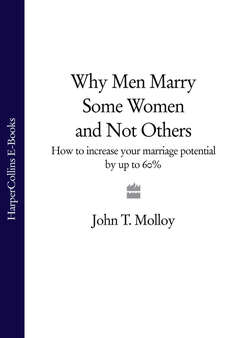Читать книгу Why Men Marry Some Women and Not Others: How to Increase Your Marriage Potential by up to 60% - John Molloy T. - Страница 9
Six Findings on the Path to Marrying Men
ОглавлениеThe first thing we learned from the research was that Kelly’s early conclusion was right on target. The primary difference between women who marry and those who do not is this:
Women who marry insist on marriage. They settle for nothing else.
The second thing we learned is:
Women who married were far less likely to have wasted their time in dead-end relationships.
Many of them told us they’d had previous relationships that were serious but broke them off because they were going nowhere.
Third:
Women who married loved themselves more than they loved any man.
You can best understand their thinking if you examine why a majority of them referred to the men they dropped as “losers.” At first I thought they meant the men were failures in business or socially, but that was not the case.
The reason most of these women thought of their former boyfriends as losers was that these men would not commit, and as a result did not meet the women’s needs.
Fourth, this study showed that:
Women who are committed to the idea of marriage are much more likely to marry than those who are not.
There is no question some women marry because they are beautiful, lucky, or charming. They meet a man they like who is crazy about them and cannot wait to marry them. Without much commitment or effort, they walk down the aisle. In most cases, however, marriage is a result of women putting pressure, sometimes subtle and sometimes not so subtle, on the men who marry them.
Which leads to the fifth statistical truth:
Women who are slender have an easier time meeting men and better odds of getting married.
The women getting their marriage licenses were more slender than the women who were single. By keeping yourself in shape and your appearance up, you’re more likely to attract men. And let’s face it, you have to attract a man before you can get close enough to him to determine whether he is marriage material.
The sixth major finding is:
Time is the single woman’s enemy.
To be on the safe side, a woman should start seriously looking for a husband in her late twenties. Assume it takes a couple of years to find out if a man is the man. If he’s not, a woman in her late twenties still has the mobility of the singles scene. She increases her chances dramatically over starting to look at age thirty-one, because it gives her several more years in the singles scene.
Naturally, there are men available at any age, but the pool of men shrinks with time, and it becomes more difficult to meet them.
Like most pop science writers, I try to explain complicated data in relatively simple terms. I am happiest when the information lends itself to listing rules or commandments: Do A, B, C, and D, but do not do E, F, G, or H; wear A, B, C, and D, but never wear E, F, G, or H. Because we are dealing with very complex relationships, this study produced few if any absolute truths. As a result, I have no unbreakable rules or commandments to offer. Instead, at the end of each chapter I list guidelines based on the statistical findings that are designed to increase your odds of marrying.
With the information this book will give you, you can arrange the odds in your favor at any age. Relationships between men and women are too complex to make guarantees, but if you’d like to have the odds on your side in your personal battle of the sexes, read on.
